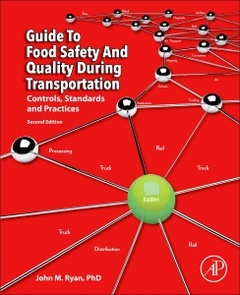Description
Guide to Food Safety and Quality during Transportation (2nd Ed.)
Controls, Standards and Practices
Author: Ryan John M.
Language: English
Subject for Guide to Food Safety and Quality during Transportation:
Keywords
accident control; adulteration; allergens; ATP testing; bin sanitation; bluetooth; calibration; calibration logs; carrier; carrier internal temperatures; causal analysis; cold chain; contact contamination; container identification (CID); container sanitation; container wash water treatment; containers; contaminant migration; cost analyses; cross-contamination; customs and border protection; data loggers; documentation; electronic documentation; equipment; excel planning; external certification audits; flowcharts; Food and Drug Administration (FDA); food carriers; food containers; food safety; food safety laws; Food Safety Modernization Act (FSMA); food safety zones; food theft; FSMA; FSMA (Food Safety Modernization Act); FSMA food transportation manager (FTM); GFSI (Global Food Safety Initiative); global positioning system (GPS); GPS; HACCP (hazard analysis and critical control points); HARPC; harvest bins; hazard analysis; homeland security; homeostasis; integrated food transportation; internal audit teams; internal audits; ISO (International Standards Organization); latent defects; liability; load; logistics; management; management responsibility; monitoring; MRB (material review board); pallets; pest control; policies; pre- and postwash records; prevention; preventive control (PC); preventive controls; procedures; process control planning; process diagram; process steps; product transportation; real-time controls; recall procedures; recall records; receiver; record keeping; records and record maintenance; records maintenance; RFID (radio frequency identification); risk based preventive controls; ROI (return on investment); seaport expansion; security; shelf life; shipper; SOP (standard operating procedure); SPC; standards; storage; tampering; temperature monitor log; temperature monitoring; TQM; TQM (total quality management); traceability; traceability installation stations; traceability systems; training; training plan
Support: Print on demand
Description
/li>Contents
/li>Readership
/li>Biography
/li>Comment
/li>
Guide to Food Safety and Quality during Transportation, Controls, Standards and Practice, Second Edition provides a solid foundation outlining logistics and delivery control solutions to protect the food transportation industry. Since its first publication, the U.S. FDA has finalized a number of Food Safety Modernization Act rules designed to improve the protection of the public from adulterants known to cause illness and death. Food shippers, carriers and receivers throughout the world are impacted as import controls have tightened. This book provides the information needed to comply with the Act?s requirements and tactics on how to achieve safety in the food supply chain.
Filled with legal, liability and practical solutions, food transporters and buyers will be able to structure company-wide business practices as part of their overall food safety and quality agendas. For food safety and quality students, the book provides much needed insight into a critical, but overlooked, aspect of the food safety and food quality spectrums. This food transporter piece of the overall food safety and quality puzzle provides the linking mechanism needed to improve the supply chain communication and interdependence sought after by governmental and industry executives.
1. Introduction to Transporter Container Sanitation, Traceability and Temperature Controls2. Recent Research and Articles3. Current and Emerging Transportation Food Safety Models4. FDA FSMA Rules on the Sanitary Transportation of Human and Animal Foods5. Impact of the FSMA Preventive Controls on Transportation Food Safety (Supply Chain Controls, Environmental Monitoring, Validation of Preventive Controls, Statistical Solutions)6. Foreign Suppliers7. Introduction to In-Transit Food Safety Auditing and Standards8. System Management and Record Keeping9. Cross Contamination through Transportation Processes10.Dairy Logistics Food Safety in Storage and Transportation11. In-Transit HARPC Planning and Implementation12. Food Cargo Theft13. Logistics Management, Sanitation, Temperature Control and Traceability Standards using a relatively low cost container identification tracking and reporting system14. Assessing your practices, training your people, preparing for audits and becoming certified15. System Implementation16. The Future
food safety professionals and government agencies, auditors, quality control personnel, transportation executives, food inspectors
- Includes important information on how to comply with the Food Safety Modernization Act
- Includes technological advances in sanitation, testing, and traceability, and highlights cost effective solutions to enhance food safety
- Provides practical solutions to transportation problems, including container sanitation, temperature controls, traceability, adulteration, and other food safety and quality issues
- Presents potential sources of adulteration, both chemical and biological at producer level, both domestic and foreign, to reduce transporter liability
- Provides new and updated information, including environmental monitoring, statistical control systems, supply-chain management, and more




